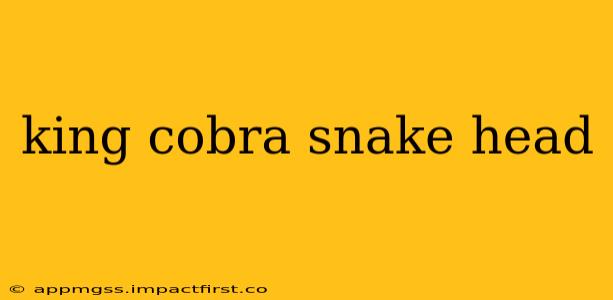The king cobra (Ophiophagus hannah), the longest venomous snake in the world, commands respect and fear in equal measure. Its head, a crucial component of its predatory arsenal, holds the key to understanding this magnificent and dangerous creature. This article delves into the fascinating anatomy of the king cobra's head, exploring its unique features and how they contribute to its hunting prowess and survival.
What are the characteristics of a king cobra's head?
The king cobra's head is distinctly different from other elapids, possessing several key characteristics. Unlike many other venomous snakes that have a triangular-shaped head, the king cobra has a more elongated, hooded head. This hood, formed by expanding ribs, is a prominent feature used in displays of aggression and defense. The head itself is relatively large in proportion to its body, reflecting its powerful jaw muscles and the size of its venom glands. The scales on the head are smooth and relatively large, differing from the keeled scales found on the body. Its eyes are large and round, providing excellent vision, crucial for both hunting and avoiding predators.
How does the king cobra use its head during hunting?
The king cobra's head is instrumental in its hunting strategy. Its large, forward-facing eyes provide accurate depth perception, allowing it to precisely strike at its prey. The powerful jaw muscles facilitate a rapid and forceful bite, delivering a lethal dose of neurotoxic venom. The elongated head also allows it to swallow relatively large prey whole, a characteristic of its ophiophagous (snake-eating) diet.
What does a king cobra's head look like when it's about to strike?
When threatened or about to strike, the king cobra flattens its neck, expanding its hood dramatically. This visual display serves as a warning, making the snake appear larger and more intimidating. The head is raised, held high and poised for a swift, accurate strike. The change in head posture and the conspicuous hood are unmistakable signs of impending attack.
How venomous is a king cobra's bite?
A king cobra bite is incredibly dangerous, delivering a potent neurotoxin that affects the nervous system. The venom's potency varies depending on various factors, including the size and age of the snake and the amount of venom injected. While its bite is lethal, it's important to note that not all king cobra bites result in fatalities. Immediate medical attention is crucial following a king cobra bite.
Does the king cobra's head have any unique defense mechanisms?
Beyond the intimidating hood display, the king cobra's head, coupled with its excellent vision and agility, serves as a primary defense mechanism. Its ability to quickly assess threats and react with a swift strike is a formidable deterrent. The speed and precision of its strike make it incredibly difficult to evade.
What is the size of a king cobra's head?
The size of a king cobra's head varies greatly depending on the size and age of the individual snake. However, as a general observation, the head is proportionally large compared to its body size. The head's length alone can measure several centimeters, providing space for the significant venom glands and powerful jaw musculature essential for its survival and hunting prowess.
Conclusion
The king cobra's head is more than just the front end of a deadly snake; it's a sophisticated and highly evolved tool that embodies the animal's predatory nature and defensive strategies. Its unique morphology, including the prominent hood, powerful jaw muscles, and sharp vision, allows the king cobra to thrive in its environment. Understanding the intricacies of the king cobra's head provides deeper insight into this remarkable species and enhances our appreciation for its place in the complex ecosystem. Further research into its physiology and behavior continues to reveal even more fascinating facts about this magnificent creature.
